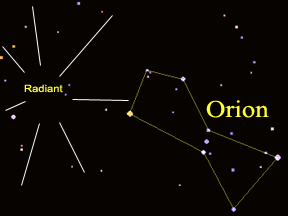This image of the nucleus of Halley's comet comes from the Giotto spacecraft.
Click on image for full size
JPL
Halley's comet
Halley's comet is named after Edmond G. Halley who was the first to suggest that comets were natural phenomena of the solar system, in orbit around the Sun. He suggested that a certain comet was a regular visitor, returning every 76 years, and was, in fact, the same one which had been observed since 240 BC, but in particular in the years 1531, 1607, and 1682, dates which for him were recent history. In 1682 he predicted the comet would return again in 1758, and sure enough, the comet arrived in March 1759. Halley's comet made a particularly bright appearance in 1910. It also was recorded in a famous ancient tapestry after its 1066 appearance.
For hundreds of years humankind has wondered what the nucleus of Halley's comet was really like. This wonderful picture from the Giotto spacecraft gives us the answer. In this picture, the Sun is on the left. Three jets can be seen blowing molecules toward the Sun. A crater can also be seen in the middle right. This image shows that evaporation occurs along specific portions of the comet. Data taken by a suite of spacecraft suggests that the comet is mostly made of ice.
Halley's comet is next scheduled to return in 2062.
You might also be interested in:

Six spacecraft flew by Halley's comet in 1986. There were two spacecraft launched from Japan, Suisei and Sakigake, and two from the Soviet Union, Vega 1 & 2. One spacecraft, ICE, from the United States
...more
When comets are kicked out of the Oort Cloud, they begin a passage into the solar system, spinning and tumbling as they come. The trajectory which they acquire can be hyperbolic, parabolic, or elliptic
...more
You may think that most objects in space that orbit something else move in circles, but that isn't the case. Although some objects follow circular orbits, most orbits are shaped more like "stretched
...more
The Orionid meteor shower happens every year in October. Meteor showers are times when you can see many meteors or "shooting stars" in one night. There are several meteor showers each year. Most meteor
...more
The Leonid meteor shower is one of several major meteor showers that occur on roughly the same date each year. The Leonids typically "peak" (are at their greatest level of activity) in mid to late November.
...more
A meteor shower is an astronomical event during which many meteors can be seen in a short period of time. Most meteor showers have a peak activity period that lasts between several hours and a couple of
...more
Hale-Bopp continues to offer new surprises as two astronomers report of their study of the comet. Using the Hubble Space Telescope and the International Ultraviolet Explorer, the astronomers did a year-long
...more















